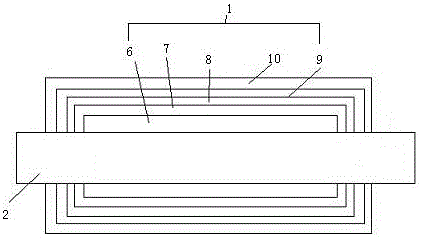Equipotential shielding tubular high-current bus and preparation method therefor
A technology of tubular busbar and shielding tube, which is applied to power cables with shielding/conducting layers, cable/conductor manufacturing, circuits, etc. environment, reduce busbar loss, and improve the effect of absorbing performance
- Summary
- Abstract
- Description
- Claims
- Application Information
AI Technical Summary
Problems solved by technology
Method used
Image
Examples
Embodiment 1
[0018] The preparation method of the equipotential shielding tube type high current busbar is as follows:
[0019] ①Wrap a layer of wave-transparent layer evenly outside the tubular busbar, the thickness of the wave-transparent layer is 0.02mm, the raw material used in the wave-transparent layer is glass fiber, put the glass fiber into the cable forming machine and react for 10min, the The temperature of the cable forming machine is 195°C;
[0020] ② Evenly wrap a layer of equipotential shielding layer outside the wave-transmitting layer. The thickness of the equipotential shielding layer is 0.01mm. The equipotential shielding layer is made of silicone rubber, and a small amount of white carbon black, diisoperoxide Prepared from propylbenzene and stearic acid, silicone rubber, white carbon black, dicumyl peroxide and stearic acid are put into a cable forming machine to react for 5 minutes, and the temperature of the cable forming machine is 175°C;
[0021] 3. Evenly wrap one ...
Embodiment 2
[0026] The preparation method of the equipotential shielding tube type high current busbar is as follows:
[0027] ① Wrap a layer of wave-transparent layer evenly outside the tubular busbar. The thickness of the wave-transparent layer is 0.04mm. The raw material used in the wave-transparent layer is glass fiber, and the glass fiber is put into the cable forming machine to react for 15 minutes. The temperature of the cable forming machine is 215°C;
[0028] ② Evenly wrap a layer of equipotential shielding layer outside the wave-transmitting layer. The thickness of the equipotential shielding layer is 0.02mm. The equipotential shielding layer is made of silicone rubber, and a small amount of white carbon black, diisoperoxide Prepared from propylbenzene and stearic acid, silicone rubber, white carbon black, dicumyl peroxide and stearic acid are put into a cable forming machine to react for 8 minutes, and the temperature of the cable forming machine is 200°C;
[0029] 3. Evenly w...
Embodiment 3
[0034] The preparation method of the equipotential shielding tube type high current busbar is as follows:
[0035] ① Wrap a layer of wave-transparent layer evenly outside the tubular busbar, the thickness of the wave-transparent layer is 0.05mm, the raw material used in the wave-transparent layer is glass fiber, put the glass fiber into the cable forming machine and react for 20min, the The temperature of the cable forming machine is 225°C;
[0036] ② Evenly wrap a layer of equipotential shielding layer outside the wave-transmitting layer. The thickness of the equipotential shielding layer is 0.03mm. The equipotential shielding layer is made of silicone rubber, and a small amount of white carbon black, diisoperoxide Prepared from propylbenzene and stearic acid, silicone rubber, white carbon black, dicumyl peroxide and stearic acid are put into a cable forming machine to react for 10 minutes, and the temperature of the cable forming machine is 215°C;
[0037] 3. Evenly wrap on...
PUM
| Property | Measurement | Unit |
|---|---|---|
| Thickness | aaaaa | aaaaa |
| Thickness | aaaaa | aaaaa |
| Thickness | aaaaa | aaaaa |
Abstract
Description
Claims
Application Information
 Login to View More
Login to View More - Generate Ideas
- Intellectual Property
- Life Sciences
- Materials
- Tech Scout
- Unparalleled Data Quality
- Higher Quality Content
- 60% Fewer Hallucinations
Browse by: Latest US Patents, China's latest patents, Technical Efficacy Thesaurus, Application Domain, Technology Topic, Popular Technical Reports.
© 2025 PatSnap. All rights reserved.Legal|Privacy policy|Modern Slavery Act Transparency Statement|Sitemap|About US| Contact US: help@patsnap.com


